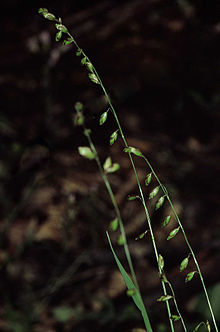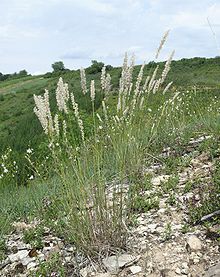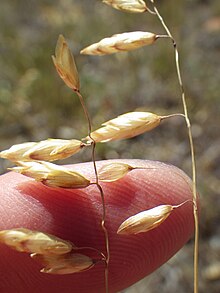Pearl grasses
| Pearl grasses | ||||||||||||
|---|---|---|---|---|---|---|---|---|---|---|---|---|

Eyelash Perlgrass (left), Nodding Perlgrass (middle) and Single Flower Perlgrass (right), illustration |
||||||||||||
| Systematics | ||||||||||||
|
||||||||||||
| Scientific name | ||||||||||||
| Melica | ||||||||||||
| L. |
The pearl grasses ( Melica ) are a genus of plants within the sweet grass family (Poaceae). The approximately 96 species are distributed in the temperate areas almost worldwide.
description
The pearl grass species are perennial herbaceous plants and reach heights of growth of up to 1 meter. They form clumps or loose lawns , often with subterranean runners . The stalks are unbranched in the vegetative area; the nodes and internodes are usually bare. The simple leaves are flat or folded and up to 30 centimeters long. The ligule is a membranous border, but it can be very short.
The inflorescence is a terminal panicle or raceme . Often the primary branches of the inflorescence lie on the axis and so the panicle is cylindrical in outline, more rarely they are spread out (e.g. in Melica uniflora ). The spikelets contain one to seven fertile flowers and usually more sterile flowers at the tip. The glumes are both almost the same and often about as long as the spikelet. The lemmas of the fertile flowers are 7 to 13 nerved, glabrous or hairy on the edge, rounded or pointed at the upper edge, but usually without an awn (rarely awned up to 12 mm long). The palea are two-veined and shorter or as long as the lemma. The number of stamens is usually three. The caryopses are bare.
Locations
Melica species often thrive in forests, while other species colonize open locations.
Systematics and distribution








The genus Melica was established by Carl von Linné . Type species is Melica nutans L.
The Melica species occur almost worldwide in the temperate areas , but are absent in Australia.
There are 96 species of Melica worldwide . The genus Melica is divided into two sub-genera, which are further subdivided into sections and subsections:
- Subgenus Melica :
- Section Melica :
- Species found in Europe, North Africa and the Middle East:
- Melica minor Boiss. , rarely occurs in the Caucasus .
- Nodding pearl grass ( Melica nutans L. ): It is common in temperate and boreal Eurasia .
- Colorful pearl grass ( Melica picta K.Koch ): Your area is disjoint in Central and Eastern Europe to the Caucasus.
- Species found in Central and East Asia:
- Melica grandiflora Koidz. , occurs in temperate East Asia.
- Melica scabrosa Trin. ex Bunge , occurs in temperate East Asia from Tibet to Korea.
- Species found in North America:
- Melica mutica Walter : It is distributed from Maryland and Florida westward to Iowa and Texas.
- Melica nitens (Scribn.) Nutt. ex Piper , extends from Minnesota to Pennsylvania and southwest to Texas and Mexico.
- Melica porteri Scribn. : It is distributed from Colorado and Arizona to central Texas and northern Mexico.
- Species found in Europe, North Africa and the Middle East:
- Section Agonomelica (Honda) W.Hempel :
- Species found in Central and East Asia:
- Melica longiligulata Z.L.Wu , native to Sichuan.
- Melica Onoei Franch. & Sav. , widely used in Japan, Korea, central and southern China, and Kashmir.
- Melica przewalskyi Roschev. , occurs in central China and Tibet.
- Melica schuetzeana W.Hempel , based in central and southern China.
- Melica taylori W.Hempel , occurs only in Tibet.
- Melica virgata Turcz. ex Trin. : It is widespread in southeastern Siberia, Mongolia and central China to Tibet.
- Melica yajiangensis Z.L.Wu : It thrives on mountain slopes at altitudes of around 2700 meters only in Sichuan.
- Species found in Central and East Asia:
- Section Dalycum Dumort. :
- Species found in Europe, North Africa and the Middle East:
- Melica bocquetii Talavera , occurs only in the mountains of southern Spain.
- Eyelash pearl grass ( Melica ciliata L. ): It is found in southern and central Europe, north Africa eastwards to the Caspian Sea.
- Melica cretica Boiss. & Hero. , in the mountains of the eastern Mediterranean.
- Melica cupanii casting. , occurs in the mountains of southern Italy, Sicily, southern Spain and northern Africa.
- Melica jacquemontii Decne. : The main distribution is in the Central Asian mountains, westward to Eastern Anatolia.
- Melica persica Kunth : The main distribution is in the Central Asian mountains and in the Iranian highlands, westward to the Levant and to southern Anatolia .
- Transylvanian pearl grass ( Melica transsilvanica Schur ), occurs from eastern southern and central Europe to Central Asia.
- Melica trebinjensis Strobl , occurs very rarely in Herzegovina and Albania .
- Species common in South America:
- Melica arzivencoi Valls & Barcellos , based in Brazil.
- Species common in southern Africa:
- Melica decumbens Thunb. : It is common in South Africa and Lesotho .
- Melica racemosa Thunb. : It is common in South Africa and Lesotho.
- Species found in Europe, North Africa and the Middle East:
- Section Altimelica W.Hempel
- Species found in Europe, North Africa and the Middle East:
- Tall pearl grass ( Melica altissima L. ): It occurs from Austria and Southeast Europe to the Caucasus, Siberia and Central Asia.
- Species common in Central and East Asia:
- Melica schafkati Bondarenko , is an endemic of the Tien Shan.
- Melica turczaninowiana Ohwi : It iswidespreadin Mongolia, North Korea , Russia's Far East , eastern Siberia and the Chinese provinces of Hebei, Heilongjiang, Henan, Nei Mongol and Shanxi.
- Species common in South America:
- Melica sarmentosa Nees , native to Argentina, Brazil, Uruguay, Paraguay and Bolivia.
- Melica scabra Kunth , common in Colombia, Ecuador, Peru and Bolivia.
- Species found in Europe, North Africa and the Middle East:
- Section Melicella Camus ex W.Hempel :
- Species found in Europe, North Africa and the Middle East:
- Melica amethystina Pourr. (Syn. Melica bauhinii All. ), Occurs in the western Mediterranean area.
- Mediterranean pearl grass ( Melica minuta L. ), occurs in the Mediterranean region and on the Canary Islands.
- Species common in Central and East Asia:
- Melica kozlovii Tzvelev : It occurs from Qinghai to Mongolia.
- Melica secunda rule : It occurs from Afghanistan to northern China and the western Himalayas.
- Melica subflava Z.L.Wu : It thrives on grassy mountain slopes at altitudes of around 3600 meters only in the Chinese province of Qinghai .
- Melica tangutorum Tzvelev : It thrives at altitudes of 1500 to 3200 meters in Mongolia and in the Chinese provinces of Gansu, Qinghai and Sichuan.
- Melica tibetica Roshev. : It thrives at altitudes of 3500 to 4300 meters in the Chinese provinces of Nei Mongol (Alxa Youqi), Qinghai , Sichuan and Tibet.
- Species common in North America:
- Melica montezumae Piper , native to western Texas and neighboring Mexico.
- Melica stricta Bol. occurs in Utah, Nevada, Oregon, and California.
- Species common in South America:
- Melica argentata E. Desv. , occurs only in Chile.
- Melica argyrea Hack. , based in Argentina, Uruguay and Brazil.
- Melica bonariensis Parodi , occurs only in Argentina.
- Melica brasiliana Ard. , occurs in Argentina, Brazil and Uruguay.
- Melica brevicoronata Roseng., BRArrill. & Izag. , occurs only in Brazil.
- Melica chilensis J. Presl , occurs in Argentina and Bolivia.
- Melica commersonii Nees ex Steud. , is a species from Chile.
- Melica decipiens Caro , occurs in Argentina, Brazil and Uruguay.
- Melica eremophila Torres , native to Argentina, Brazil, Uruguay and Bolivia.
- Melica glabrescens (Torres) Torres , a species of Argentina.
- Melica hunzikeri Nicora , occurs only in Argentina.
- Melica hyalina Döll , based in Argentina, Brazil and Uruguay.
- Melica lilloi Bech. , occurs only in Argentina.
- Melica longiflora Steud. , occurs only in Chile.
- Melica mollis Phil. , Only occurs in Chile.
- Melica parodiana Torres , occurs in Argentina and Uruguay.
- Melica patagonica Parodi , occurs only in Argentina.
- Melica paulsenii Phil. , Endemic to Chile.
- Melica poecilantha E. Desv. , occurs only in Chile.
- Melica rigida Cav. , in Argentina, Brazil and Uruguay.
- Melica riograndensis Longhi-Wagner & Valls , occurs only in Brazil.
- Melica spartinoides L.B. Sm. , Only occurs in Brazil.
- Melica stuckertii hack. , is common in Argentina and Bolivia.
- Melica tenuis hack. & Arechav. , occurs in Argentina, Brazil and Uruguay.
- Melica violacea Cav. , is limited in its distribution to Chile.
- Species found in Europe, North Africa and the Middle East:
- Section Macrae W.Hempel :
- Melica macra Nees , native to Argentina, Uruguay and Brazil.
- Section Penicillaris W.Hempel :
- Melica penicillaris Boiss. & Balansa , occurs only in Anatolia.
- Section Melica :
- Subgenus Bulbimelica W.Hempel :
- Section Bromelica (Thurber) Hitchcock :
- Species common in North America:
- Melica aristata Thurb. ex Bol. , is common on the west coast of the United States from Washington to southern California.
- Melica bulbosa Geyer ex Porter & JMCoult. , is common in temperate western North America.
- Melica californica Scribn. , occurs in Oregon and California.
- Melica frutescens Scribn. , grows in southern California, Arizona, and bordering Mexico.
- Melica fugax Bol. , its range extends from British Columbia to California and east to Nevada and Idaho.
- Melica geyeri Munro , occurs in Oregon and California.
- Melica harfordii Bol. , grows on the Pacific coast from Vancouver Island to California.
- Melica hitchcockii B. Boivin , occurs only in Alberta.
- Melica smithii (Porter ex A.Gray) Vasey , has a disjoint distribution area from British Columbia and Alberta south to Oregon and Wyoming on the one hand and from the Great Lakes to western Quebec on the other.
- Melica spectabilis Scribn. , occurs in western North America.
- Melica subulata (Griseb.) Scribn. occurs in western North America from the Aleutian Islands and Alaska to California.
- Species common in South America:
- Melica cepacea (Phil.) Scribn. , is the only type of section in Chile.
- Species common in North America:
- Husnotchloa Tzvelev Section :
- Species found in Europe, North Africa and the Middle East:
- Melica rectiflora Boiss. & Hero. : It occurs only in the Peloponnese, Crete, Karpathos and Amorgos .
- Single-flowered pearl grass ( Melica uniflora Retz. ): It is widespread in temperate to submeridional Europe and with a few outposts in northwest Africa and extends in the east to the Caucasus and the Elbrus Mountains.
- Species common in North America:
- Melica imperfecta Trin. : its range extends from California and southern Nevada to Baja California.
- Melica torreyana Scribn. : It only occurs in California.
- Species found in Europe, North Africa and the Middle East:
- Section Bromelica (Thurber) Hitchcock :
Without assignment to a section:
- Melica smirnovii Tzvelev : This species, newly described in 2012, occurs in European Russia.
- Melica animarum Muj.-Sall. & M.Marchi : The species first described in 2005 occurs in Uruguay.
- Melica chatkalica Lazkov & Usupbaev : The species first described in 2017 occurs in Kyrgyzstan.
- Melica serrana Muj.-Sall. & M.Marchi : The species first described in 2005 occurs in Uruguay.
The following nature hybrids are recognized:
- Melica × aschersonii M. Schulze = Melica nutans × Melica picta
- Melica × haussknechtii W.Hempel = Melica ciliata × Melica persica
- Melica × thuringiaca Rauschert = Melica ciliata × Melica transsilvanica
- Melica × tzvelevii W.Hempel = Melica altissima × Melica ciliata
- Melica × weinii W.Hempel = Melica nutans × Melica uniflora
literature
- Hans Joachim Conert: Melica. In: Hans Joachim Conert (ed.): Illustrated flora of Central Europe . Founded by Gustav Hegi. 3rd, completely revised edition. Volume I. Part 3: Spermatophyta: Angiospermae: Monocotyledones 1 (2). Poaceae (real grasses or sweet grasses) . Parey Buchverlag, Berlin 1998, ISBN 3-8263-2868-X , p. 457-470 (published 1979-1998).
- Thomas Gaskell Tutin : Melica L. In: TG Tutin, VH Heywood, NA Burges, DM Moore, DH Valentine, SM Walters, DA Webb (eds.): Flora Europaea . Volume 5: Alismataceae to Orchidaceae (Monocotyledones) . Cambridge University Press, Cambridge 1980, ISBN 0-521-20108-X , pp. 178-179 (English).
Individual evidence
- ↑ a b c d e f g h i j k l Werner Hempel : Revision and phylogeny of the species of the genus Melica L. (Poaceae) in Eurasia and North Africa. In: Fedde's repertory. Volume 122, No. 1–2, pp. 1–253, DOI: 10.1002 / fedr.201100029 .
- ↑ a b c Walter Erhardt , Erich Götz, Nils Bödeker, Siegmund Seybold: The great pikeperch. Encyclopedia of Plant Names. Volume 2. Types and varieties. Eugen Ulmer, Stuttgart 2008, ISBN 978-3-8001-5406-7 .
- ↑ a b c d Mary E. Barkworth: Melica. In: Flora of North America Editorial Committee (Ed.): Flora of North America North of Mexico . Volume 24: Magnoliophyta: Commelinidae (in part): Poaceae (part 1) . Oxford University Press, New York / Oxford a. a. 2007, ISBN 978-0-19-531071-9 (English, online ).
- ↑ a b c d e f g h RJ Soreng: Melica. In: Catalog of New World Grasses (Poaceae): IV. Subfamily Pooideae. In: Contributions from the United States National Herbarium. Volume 48, 2003, pp. 432-450, digitized version , updated version on Tropicos.org , accessed on September 22, 2012.
- ↑ a b c d e f g h i Rafaël Govaerts (Ed.): Melica. In: World Checklist of Selected Plant Families (WCSP) - The Board of Trustees of the Royal Botanic Gardens, Kew . Retrieved January 24, 2020.
- ↑ a b c d e f Zhen-lan Wu, Sylvia M. Phillips: Melica. In: Wu Zheng-yi, Peter H. Raven, Deyuan Hong (Eds.): Flora of China . Volume 22: Poaceae . Science Press / Missouri Botanical Garden Press, Beijing / St. Louis 2006, ISBN 1-930723-50-4 , pp. 216–223 (English, online - PDF file ).
- ↑ a b Werner Hempel: The questionable structure of the genus Melica L. In: Haussknechtia. Volume 10, 2004, pp. 169-198.
- ↑ data sheet at PlantzAfrica .
- ↑ Data sheet Melica racemosa of the Intermountain Herbarium of Utah State University. ( Memento of the original from March 4, 2016 in the Internet Archive ) Info: The archive link was inserted automatically and has not yet been checked. Please check the original and archive link according to the instructions and then remove this notice.